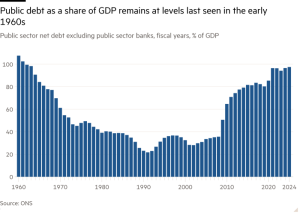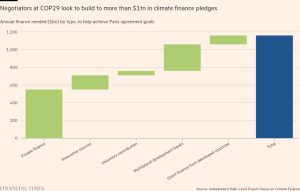Faulty data overstates surge in UK economic inactivity, finds report

Unlock the Editor’s Digest for free
Roula Khalaf, Editor of the FT, selects her favourite stories in this weekly newsletter.
The UK labour market is in a better state than official data suggests, according to new analysis that finds there has been no surge in the rate of economic inactivity since the pandemic.
The Office for National Statistics’ labour force survey, the main source of data on unemployment, has suffered from a sharp drop in response rates and a potential bias in the types of people likely to respond.
This official data has led policymakers to focus on a problem apparently unique to the UK: while other countries registered a post-pandemic surge in employment, Britain’s workforce shrank with a rising share of people saying long-term health conditions stopped them looking for a job.
But Adam Corlett, principal economist at the Resolution Foundation, said these figures “misrepresented” what had happened in the jobs market and had given policymakers “an overly pessimistic picture”.
A report published on Wednesday by the think-tank paints a very different picture.
Its estimates are based on HMRC tax records that suggest the LFS has been underestimating growth in the workforce by some 930,000. They are also based on the latest population data, which reflects two years of record high immigration and which the ONS has not yet applied to the LFS.
Corlett said the administrative data suggested the UK’s employment rate for 16 to 64-year-olds was around 76 per cent, as it was before the pandemic, rather than its official rate of around 75 per cent.
It is less certain whether those not working are unemployed, or choosing to step out of the labour market. But Corlett said that based on historic patterns, the rate of economic inactivity was likely to be little changed from its 2019 rate — at around 36 per cent of the population aged over 16.
Even if the split between unemployment and inactivity had changed, with unemployment falling to record lows, the inactivity rate would still be no worse than in 2017, the analysis showed.
The finding is significant because policymakers have seen the unusual rise in economic inactivity — which has been accompanied by a sharp rise in claims for health-related benefits — as a key constraint on growth, a source of inflationary pressure and a strain on the public finances.
But official data has been “underestimating people’s chances of having a job, overstating the scale of Britain’s economic inactivity challenge, and likely overestimating productivity growth,” Corlett said.
The Bank of England has already started to take a more sceptical view of the data.
Huw Pill, BoE chief economist, wrote to the ONS earlier this year underlining the urgency of fixing the LFS, noting that discrepancies between sources “make the difference between labour force participation having declined substantially since 2019 or having already recovered its pre-pandemic level”.
Economic inactivity remains a key focus for the government, which pledged before the election to “get Britain working” and raise the employment rate to 80 per cent.
Liz Kendall, work and pensions secretary, is set to launch a package of reforms to jobcentres and the wider job support system this month, focused on helping the almost 4mn people currently claiming health-related benefits.
“There are enormous questions here for the ONS to answer,” said George Bridges, chair of the House of Lords Economic Affairs Committee, which is conducting an enquiry into the relationship between welfare and long-term sickness.
There was “a wealth of data” held within government that should be analysed to urgently answer “very basic questions” while the LFS remained unreliable, he said.
The Resolution Foundation said the rising benefit caseload did point to increasing levels of long-term sickness and potentially to higher levels of health-related inactivity.
However, this did not necessarily mean the inactivity rate had risen overall.
Many people who had begun claiming benefits in the past few years were already out of work, and there had been offsetting falls in the number inactive for other reasons, such as family responsibilities.
Xiaowei Xu, senior research economist, at the Institute for Fiscal Studies, also said the LFS could be overstating the rise in health-related inactivity — which appeared to be concentrated in the 50-64 age group where the survey diverged most from HMRC’s data.
The report called for the ONS to do more to reconcile the data sources, saying the agency “needs to resolve the fact that Britain’s labour market stats aren’t working”.
The ONS said it had introduced many new data sources, including HMRC tax records, “to improve the quality, granularity and timeliness” of its statistics, and had been “clear for some time” that the HMRC figures were likely to be more accurate than the LFS.
Ongoing work to boost the LFS sample size and reweight the data using the latest population estimates would help to improve the quality of the survey, the agency said, adding that it was “working with outside experts to assess if any further action may need to be taken”.
The Department for Work and Pensions was approached for comment.
#Faulty #data #overstates #surge #economic #inactivity #finds #report





